The most distinctive symbol of Bristol is a famous bridge.
In this post, you’ll discover the ultimate list of facts about Clifton Suspension Bridge, one of the most picturesque bridges in the world!
1. It spans the Avon Gorge and the River Avon
The Clifton Suspension Bridge is located in the city of Bristol in the southwest of England and connects Clifton in Bristol to Leigh Woods in North Somerset.
In order to do so, it spans the River Avon which runs through the Avon Gorge, a 1.5-mile (2.5-kilometer) gorge that runs all along the western part of the city.
This gorge also forms the boundary between the unitary authorities of North Somerset and Bristol.

2. The Clifton Suspension Bridge is over 331 feet high
From some angles, you might not realize how high this bridge really is, but it’s actually 331 feet (102.2 meters) high with the height of the towers included which stand 86 feet (26.2 meters) tall.
You better don’t be afraid of heights when leaning over the edge because the clearance below the deck is 245 feet (76 meters) above high water level as well!
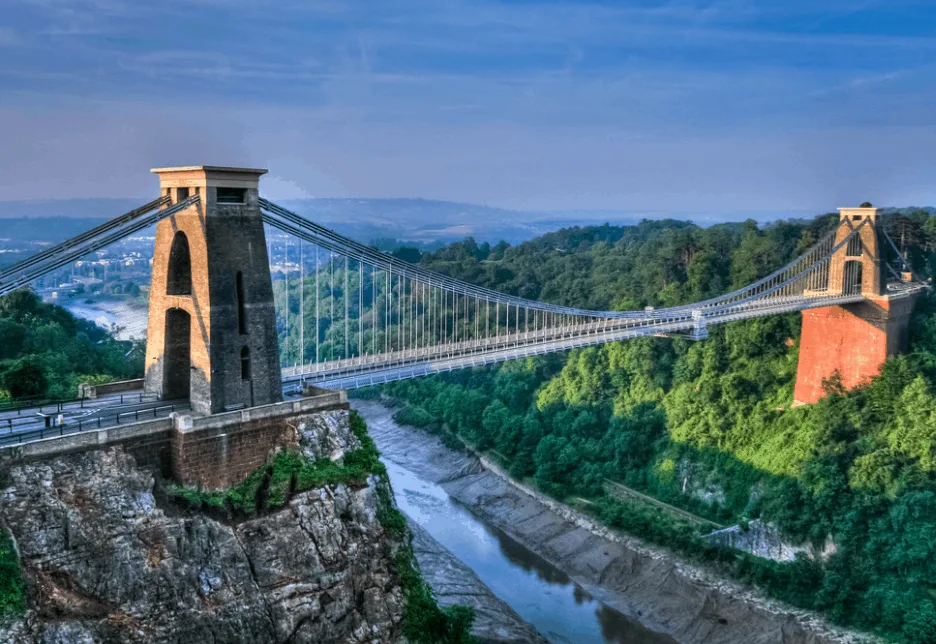
3. The bridge opened in the 1860s
The story of the Clifton Suspension Bridge started all the way back in 1753 when the idea to build a bridge on its location first surfaced.
One of the most remarkable facts about Clifton Suspension Bridge is that this original idea was turned into this amazing structure and opened well over a century later in 1864!
4. A rich Bristolian left money in his will for a bridge

A rich merchant and Bristolian named William Vick was the man who came up with the idea to build a bridge in its current location. This was quite a visionary idea because this area wasn’t very developed yet halfway through the 18th century.
To make things even better, he left about £1,000, which is the equivalent of over £150,000 today, in his will for the purpose of constructing the bridge.
The money was to be put into a bank account and the interest was to be accumulated until enough money was in it to fund the project. His estimate was that £10,000 would be needed to build a stone bridge.

5. The bridge was built as an alternative the old Bristol Bridge
With the generous offer of Mister Vick, time went by and the money accumulated, but no plans were made to actually create the bridge the following decades.
An event referred to as the “Bristol Bridge Riots” in 1793, when an angry mob caused havoc in the city as they complained about the toll prices on the old Bristol Bridge, finally ensured plans were finally conceived to build a bridge that would create another crossing over the River Avon.
This means that the idea to build the bridge was simply to have an alternative to cross the River Avon apart from the Bristol Bridge, which was the only stone bridge in the city since the 13th century.
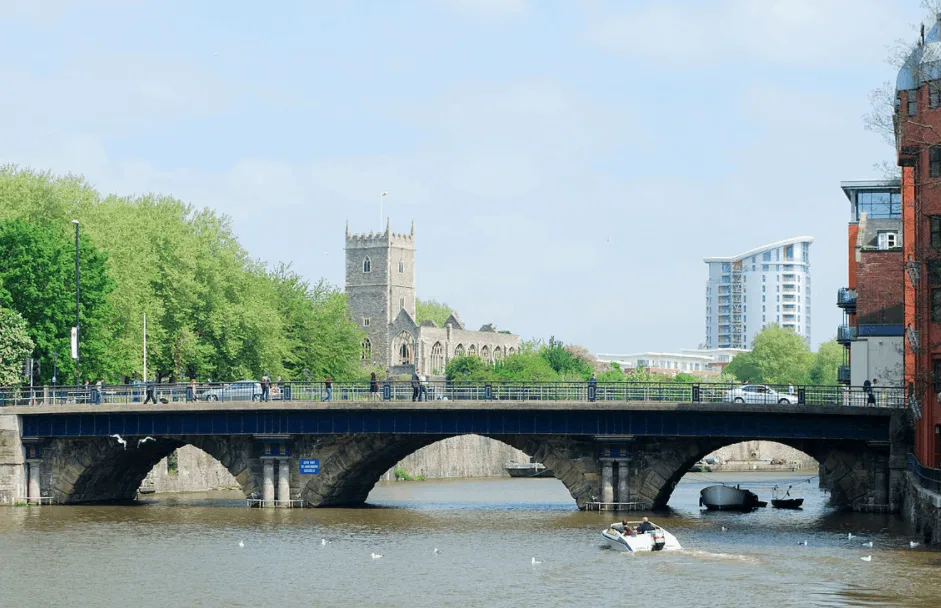
6. The original plan included a bridge with factories
The first time a plan for a bridge was conceived was in 1793, shortly after the Bristol Bridge Riots, when William Bridges created a plan for a bridge that included factories from the base all the way to the top of the bridge.
These factories were then supposed to generate income for the bridge after it was constructed. After all, this plan was made to solve the problem of a high toll to cross it, right?
Unfortunately, the French Revolution was ongoing at the time resulting in serious damage to European economies. New factories weren’t profitable and the plan ended up being shelved.
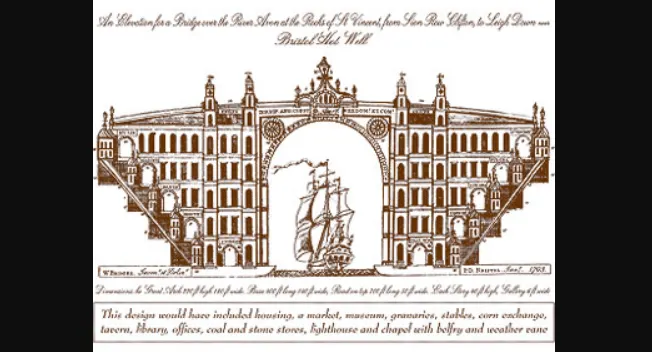
7. An architectural competition didn’t initially find a winning design
An architectural competition was held in 1829 to finally find a design for the bridge and a reward of 100 guineas (a gold coin) was offered as a reward.
A total of 22 designers all submitted their plans and each of these had a total cost of between £30,000 and £93,000. That was much more than the £8,000 that had been accumulated in the bank account of William Vick at the time, so 17 of the 22 plans were instantly shelved as well.
Scottish Civil Engineer Thomas Telford looked closely at the remaining 5 plans and rejected all of them as well. Instead, he worked on a plan of his own consisting of a bridge with tall Gothic towers costing about £52,000.
It’s clear that the competition wasn’t a success…
8. The bridge’s architect rejected his father’s opinion
The first competition didn’t work out to find a winning design, but that didn’t mean that the project was abandoned. Instead, money was raised and an Act of Parliament was passed to change the design from a stone bridge to a wrought iron suspension bridge.
It was also included that the management could charge a toll to cross the bridge, which is peculiar because that’s the reason the bridge was built.
Isambard Kingdom Brunel, considered to be one of the most ingenious and prolific figures in engineering history,” submitted a plan which reduced the cost with £10,000 and became the one that was chosen from the 13 designs submitted in the second design competition.
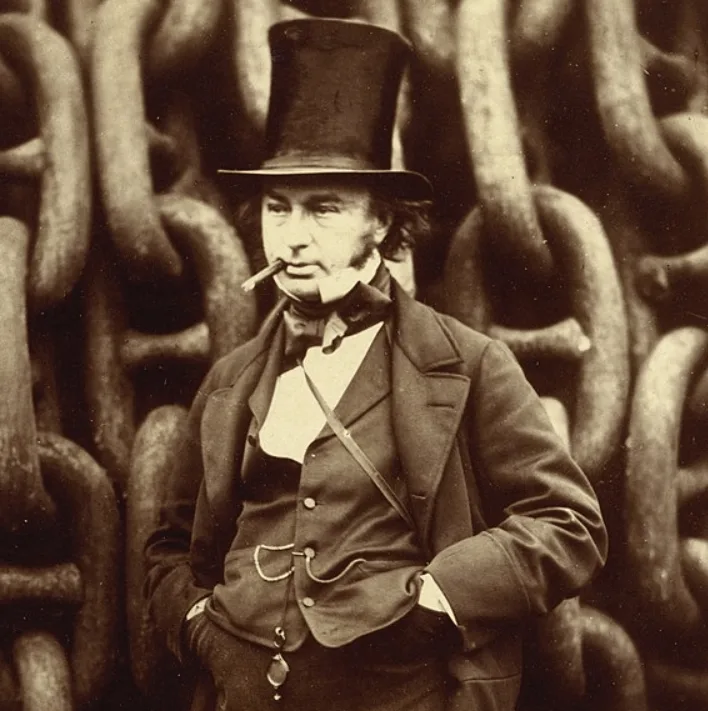
9. The bridge almost looked completely different
Isambard Kingdom Brunel was the son of Sir Marc Isambard Brunel, an equally renowned engineer. When the son first showed the design to his father, his instant reaction was that he didn’t think such construction with a single span could be built.
In letters found between the two, it was discovered that his father actually recommended adding a central support tower to the bridge. This suggestion was ignored by the son who after all was one of the best engineers in history.
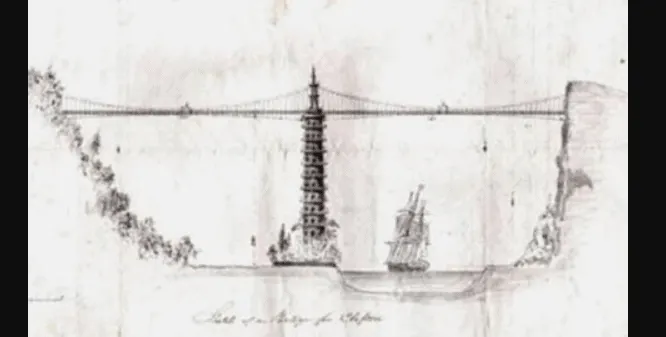
9. Construction of the bridge was halted by the Bristol Riots
On Monday, June 20, 1831, it was finally the day to mark the start of the construction of the Clifton Suspension Bridge. This was done by the blasting of St. Vincent’s Rock, a massive piece of rock that needed to be removed.
Just 4 months later the Bristol Riots, which started after a reform bill was rejected, halted the construction as funds were running dry. It wasn’t until the year 1836 that attempts were made to restart the project, most of them unsuccessful.
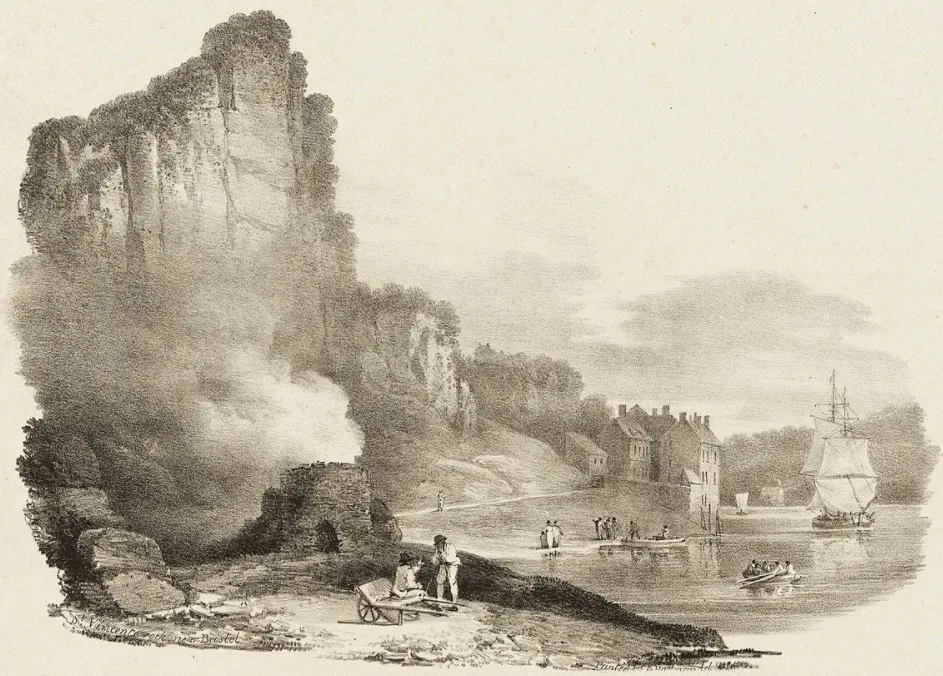
10. Brunel never saw the completion of the bridge he designed
Things didn’t pick up until tragedy struck. Brunel died in 1859 from a kidney disease caused by smoking, just after the completion of one of his most famous designs, one of the 7 wonders of the industrial world, the massive ship the SS Great Eastern.
It was his colleagues in the Institution of Civil Engineers that set things in motion for the bridge to be completed as they felt it would be a fitting tribute to his work and life.
A company to manage the bridge was created back in 1860, funds were raised by selling shares, and construction resumed until the bridge was completed on December 8, 1864.

11. Can Brunel really be credited with the design?
Before the construction started again in 1862, serious revisions were made to the design of the bridge by William Henry Barlow and Sir John Hawkshaw. Some people claim that these revisions basically turned the design into a completely new bridge.
The deck was much wider than the original design, it uses triple and not double chains, and the towers weren’t finished in an Egyptian style but simply rough stone.
An even more astounding recognition came when a mother-of-six from Bristol named Sarah Guppy officially got credit for the design of the bridge when her patented suspension bridge from 1811 was considered to be the real designer of the Clifton Suspension Bridge.
That’s why, if you look in the Oxford Dictionary, you’ll see “Sarah Guppy” as the designer of the bridge, not Brunel.

13. The bridge is now managed by a charitable trust
Ever since the bridge opened, a small fee was charged for motor vehicles to cross the bridge. This income was managed by a company initially which was turned into a charitable trust called the “Clifton Suspension Bridge Trust.”
The income is mainly used for the maintenance and painting of the bridge.
14. The bridge earns millions of pounds every year
In the 19th century, the bridge didn’t earn too much. This seriously changed after the First World War as more and more vehicles were crossing the bridge.
Right now, about 4 million vehicles cross the bridge each year, and the toll has been set at £1 since 2012 (the bridge is free to cross for pedestrians and bicycles). This means that the Trust operating the bridge has an annual revenue of over £4 million!
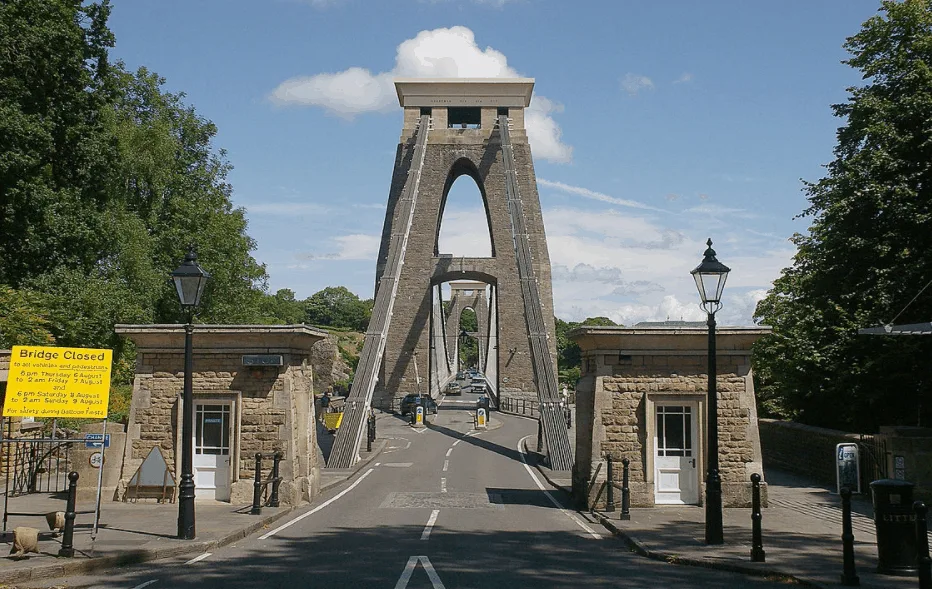
15. A historical bungee jumping event happened in 1979
Is there a better place to perform a historical stunt?
One of the most fascinating facts about the Clifton Suspension Bridge is that the first-ever modern bungee-jumps happened on April 1, 1979, right from the Clifton Suspension Bridge.
The initiative was taken by members of the University of Oxford Dangerous Sports Club, who was arrested shortly after the stunt. They did continue, however, and jumped from the Golden Gate Bridge and the Royal Gorge Bridge, spreading the concept of bungee jumping worldwide!

16. The Clifton Suspension Bridge has amazing LED lights
The opening of the Clifton Suspension Bridge was celebrated by a large number of magnesium flares. Unfortunately, these didn’t last long as they were blown out by the wind.
To avoid another fiasco like this, thousands of light bulbs were attached to the bridge to lighten up the bridge at night.
Since 2006, on the year of the 200th anniversary of the birth of Isambard Kingdom Brunel, LED lights were introduced which give the bridge an amazing appearance at night!
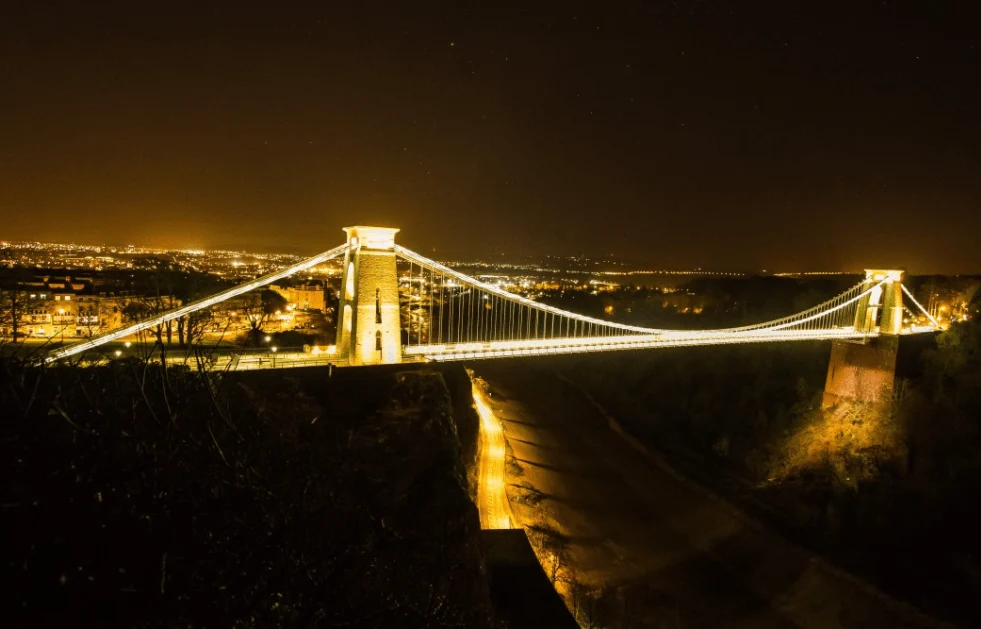
17. A visitor center documents the entire history of the bridge
It’s clear that the annual income of the Clifton Suspension Bridge Trust exceeds the maintenance cost because, in 2011, it was announced that a completely new visitors center would be constructed on the Leigh Woods end of the bridge.
This center cost a whopping £2 million, followed by an additional £595,000 raised in a lottery to improve the visitor center.

